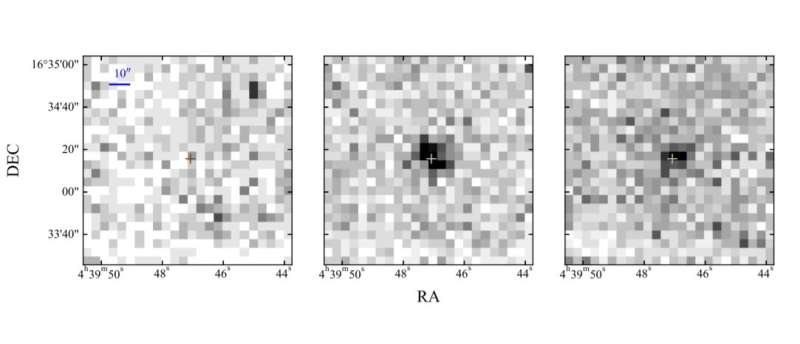December 29, 2021 report
Distant quasar J0439+1634 explored in X-rays

Using ESA's XMM-Newton spacecraft, an international team of astronomers has conducted X-ray observations of the most distant known gravitationally lensed quasar—J0439+1634. Results of the study, published December 20 on the arXiv pre-print server, shed more light on the properties of this source.
Quasars, or quasi-stellar objects (QSOs), are extremely luminous active galactic nuclei (AGN) containing supermassive central black holes with accretion disks. Their redshifts are measured from the strong spectral lines that dominate their visible and ultraviolet spectra.
Astronomers are especially interested in studying high-redshift quasars (at redshift higher than 5.0) as they are the most luminous and most distant compact objects in the observable universe. Spectra of such QSOs can be used to estimate the mass of supermassive black holes that constrain the evolution and formation models of quasars. Therefore, high-redshift quasars could serve as a powerful tool to probe the early universe.
At a redshift of 6.52, J0439+1634 the first known gravitationally lensed high-redshift quasar. Its high lensing magnification makes it an excellent target for the study of X-ray emission from a reionization-era QSO that is intrinsically less luminous.
J0439+1634 is also the so-called broad absorption line (BAL) quasar. In general, BAL quasars are assumed to be highly absorbed in the soft X-ray band and are generally X-ray weak in observations of low-redshift quasars. However, to date no such studies of high-redshift BAL QSOs have been carried out, due to their faint X-ray emission.
So a team of researchers led by Jinyi Yang of the University of Arizona decided to explore J0439+1634 with the European Photon Imaging Camera (EPIC) system onboard XMM-Newton. They investigated the X-ray properties of this source through spectral analysis and compared the results with other quasar populations.
J0439+1634 was identified as an X-ray source with XMM-Newton in the 0.5–10 keV band by all three EPIC cameras, while it was not detected in the 0.2–0.5 keV band. The EPIC spectra show that the quasar has a flat photon index—at a level of approximately 1.45.
The observations found that the optical-to-X-ray spectral slope of J0439+1634 is about −2.07 suggesting that this quasar is underluminous by a factor of 18 in X-rays, which is consistent with the behavior of BAL QSOs observed at lower redshift. The astronomers noted that their study marks the first time when an X-ray weak BAL quasar at a redshift of above 6.0 has been observed spectroscopically.
Furthermore, spectral fitting using an absorbed power-law model suggests a high intrinsic column density in the case of J0439+1634—more than 200 sextillion cm-2. This finding, according to the researchers, suggests that J0439+1634 is the first highly obscured quasar with X-ray spectroscopy in the reionization epoch. They assume that this source could be an intrinsically X-ray weak quasar.
More information: Deep XMM-Newton Observations of an X-ray Weak, Broad Absorption Line Quasar at z=6.5, arXiv:2112.10785 [astro-ph.GA] arxiv.org/abs/2112.10785
© 2021 Science X Network




















